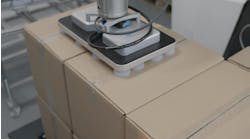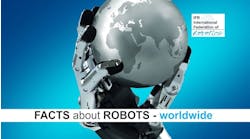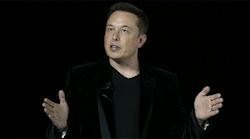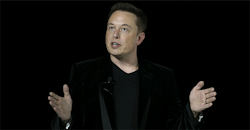he hints, the tweets, the will-he-or-won’t-he suspense. It was classic showman Elon Musk.
Then his much-hyped 1,500-word manifesto dropped and -- whiff. The maestro may have struck out. His groupies still idolize the billionaire-genius behind PayPal, SpaceX, Tesla Motors Co. and SolarCity Corp., the dreamer who wants to build hyperloops and colonize Mars. But recently, puffs of doubt have begun to surround the inspiration for Tony Stark in the “Iron Man” movies. After mesmerizing Wall Street for years, investors are starting to look for him to do something new: deliver financial results, or at least a road map for them.
FREMONT, CA - SEPTEMBER 29: Tesla CEO Elon Musk speaks during an event to launch the new Tesla Model X Crossover SUV on September 29, 2015 in Fremont, California. After several production delays, Elon Musk officially launched the much anticipated Tesla Model X Crossover SUV. The (Photo by Justin Sullivan/Getty Images)
The skepticism was on full display Thursday, after he unveiled his latest “master plan” to more than a few yawns. Tesla’s stock price slipped 3.4 percent to close at $220.50.
The company had no comment about the decline in shares or criticism from investors. “What Elon said yesterday stands,” said a Tesla spokesperson in an e-mail. Three board members did not respond to request for comment.
Quintessential Musk, the mission statement he posted Wednesday night was long on futuristic vision and short on details about things like how he’ll get his hands on the vast sums of cash he’ll need to execute all his ideas -- for a new company blending Tesla and SolarCity, for an integrated solar-battery product, for electric buses and trucks, for autonomous ride-sharing fleets.
“There is no real meat to chew on here,” said Dave Sullivan, an analyst at AutoPacific Inc., “which should only fuel skepticism and concern for cash burn.” Without details about timelines and financing, said Bloomberg Intelligence auto analyst Steve Man, “It is all just noise.”
‘Elon’s Brain’
That’s blasphemy to devotees in his fervent fanbase of early Tesla vehicle owners, many of whom are also investors. The 45-year-old enjoys cult-like status across several sectors, as the architect of the first sexy all-electric car, founder and chief executive officer of SpaceX, the rocket-maker aiming for the red planet, and chairman of solar-panel producer SolarCity.
Musk the pitchman had kept them on tenterhooks for more than a week with tweets promising imminent delivery, and loyalists weren’t disappointed. “Elon’s brain is in a world that is 40 years ahead of the rest of the world,” said Sandip Gupta of Folsom, California, who owns two Teslas, a Model S and a Model X, and has reserved a Model 3. “Just take a sip of his Kool-Aid and you are transported to a virtual-reality world.”
Missed Targets
What Musk called “Master Plan, Part Deux” came out after a rocky month for Tesla. The company has been on the defensive with Autopilot, its driver-assist technology, following a fatal Florida crash that spurred an investigation by U.S. safety regulators. A key manufacturing executive departed for Facebook Inc. Tesla delivered 50,658 cars last year and said it would deliver at least 80,000 this year, but missed its first two quarterly sales targets.
And Musk’s $2.86 billion proposal to acquire SolarCity -- which is run by two of his cousins and of which he owns more than 20 percent -- has been panned, raising concerns about corporate governance and the idea of adding more debt to Tesla’s balance sheet. Tesla, which has had one profitable quarter since its 2010 initial public offering, has long-term debt of $2.5 billion and $1.4 billion in cash and equivalents.
Curbed Enthusiasm
Even one of Musk’s biggest cheerleaders, Morgan Stanley analyst Adam Jonas, has curbed his enthusiasm. Jonas recently lowered his recommendation on the stock and reduced his 12-month target to $245 from $333. In a note Thursday, Jonas was skeptical of the master plan’s feasibility. “Are public investors prepared to continue to extend capital on the same terms they have done over the past six years?” The note’s title: “Now That They’ve Said It, How Do They Fund It?”
The CtW Investment Group, which represents union-sponsored pension funds, blasted the plan and renewed calls for greater independence on Tesla’s seven-person board. Members include Musk’s brother, Kimbal Musk and Antonio Gracias, who’s also a SolarCity director.
“Given the inbred, interlocked nature of Tesla’s board, we fear that its directors do not have the independence needed to adequately assess and execute the SolarCity transaction much less the broader ‘Master Plan,” said Dieter Waizenegger, the group’s executive director. A two-person committee of SolarCity board members is evaluating the offer. (In the master plan, Musk said the fact that Tesla and SolarCity are separate companies “is largely an accident of history.”)
Making Sense
Ross Gerber, co-founder and CEO of Gerber Kawasaki Wealth and Investment Management, which owns 25,000 Tesla shares, said what Musk laid out in his decree makes sense in the long run and could work -- though it won’t buy Gerber’s support for a SolarCity deal.
“I only care about my clients,” Gerber said. “I don’t care about a master plan. I don’t want to be in solar. Don’t make me buy into that business.”
Musk envisions taking on Daimler AG in the semi-truck business, the startup Proterra Inc. with electric buses and the ride-sharing behemoth Uber Technologies Inc. when it comes to on-demand mobility. That’s a grand vision that could start to meet resistance from shareholders if Musk sells more stock to raise funds, shrinking their piece of Tesla, said Morningstar Inc. analyst David Whiston.
Has Musk lost his spell over investors? “I’m not ready to say that yet,” Whiston said. But if the SolarCity deal doesn’t go through, well, “then he’s lost his mojo.”











